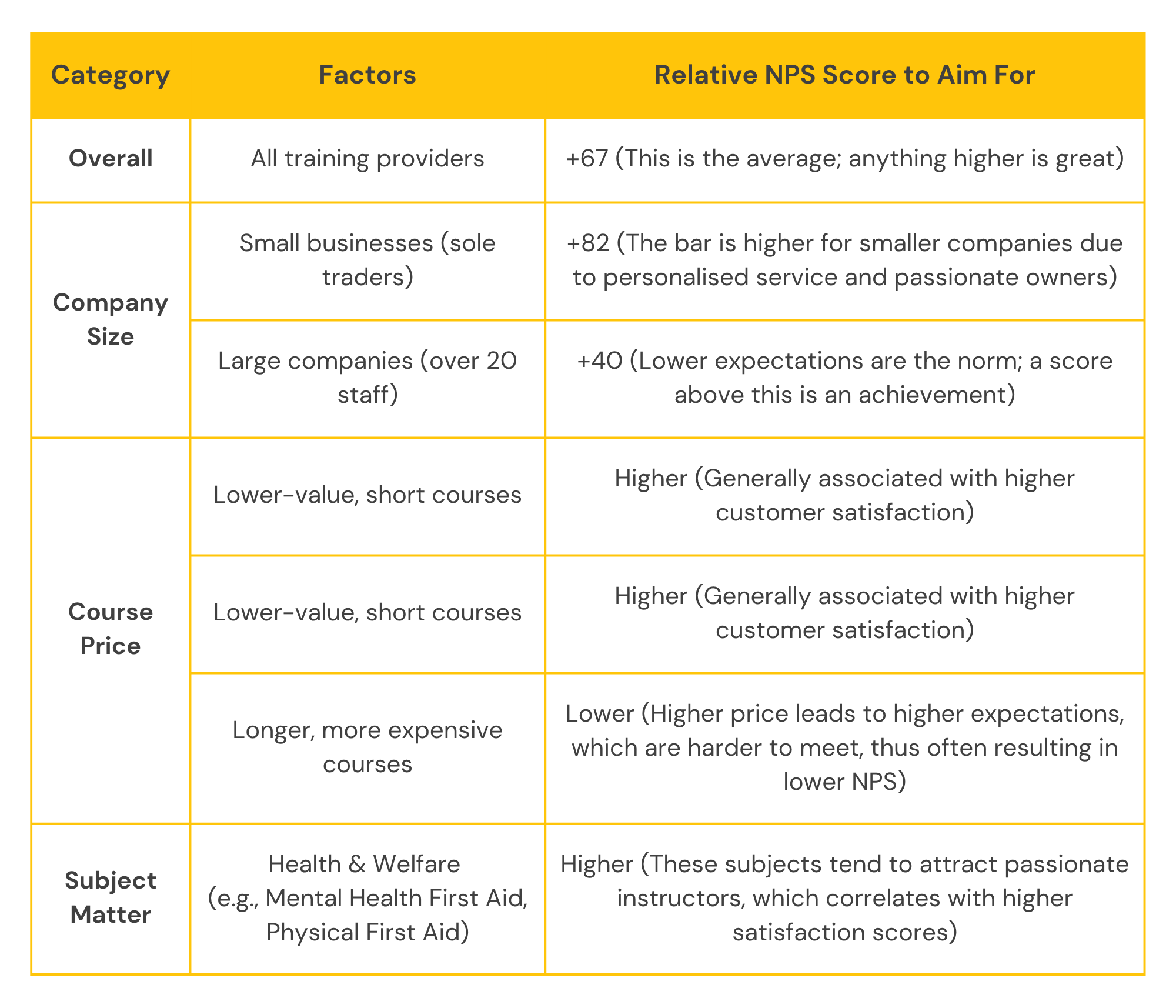
The Net Promoter Score (NPS) is a powerful metric that has redefined how businesses measure customer loyalty, satisfaction, and enthusiasm. It has become one of the most reliable ways to understand how people truly feel about a brand.
Instead of just collecting star ratings or end-of-course surveys, it digs deeper into loyalty and long-term satisfaction.
The NPS methodology was introduced in 2003 and has since become an industry-standard tool across many sectors, including internal and external training programmes.
This blog will explore:
- Why Net Promoter Score is a strategic tool
- How it can help measure true learner loyalty and predict long-term growth
- NPS is and why it’s more useful than average ratings for training providers
- How to benchmark your scores against industry standards.
What is the Net Promoter Score (NPS) for training providers?
While commonly associated with sales, marketing and political polling, the NPS framework is a system that can be adapted to evaluate a wide range of activities, products or services.
NPS allows training providers to see the bigger picture of the learner’s experience, essentially showing how likely your learners are to endorse your training to others.
Unlike simple average ratings, which offer a limited, transactional view by telling you how someone felt in the moment, NPS shows whether they’re likely to recommend you, return, and stay engaged over time.
At its core, NPS is a single number, ranging from -100 to 100, that quantifies a customer's likelihood of recommending a company's training programme to others.
How NPS works and what it helps training providers measure
The entire system is built around a single, simple question:
“On a scale of 0–10, how likely are you to recommend us (or this course) to a friend or colleague?”
Respondents are categorised as:
- Promoters (scores 9-10)
- Passives (scores 7-8)
- Detractors (scores 0-6).
The NPS is then calculated by subtracting the percentage of Detractors from the percentage of Promoters, yielding a score between -100 and +100.
The key differentiator here is that the question focuses on a future action. A standard satisfaction survey ("How satisfied were you?") usually asks people to reflect on what happened, providing a retrospective view of a past experience. While this is useful, it only captures a snapshot of one moment.
The NPS question, on the other hand, forces the respondent to consider their entire experience with the training provider and whether they are willing to put their reputation on the line to recommend it to a peer. This simple shift turns NPS into a strong signal of both loyalty and potential growth.
NPS vs. average ratings: why NPS wins
While useful, average scores can be misleading, as they tend to cluster in a narrow range (many courses might score between 4.5 and 4.8 out of 5), making it hard to discern meaningful differences or trends.
The problem is that averages smooth everything out, which means a few frustrated learners can disappear behind the majority’s positive ratings. For example, a course might show a healthy average of 4.6 stars, but buried in that number could be a cluster of detractors that the flat average won’t highlight.
NPS, on the other hand, provides a clearer signal. By categorising respondents, NPS explicitly calls out the proportion of detractors versus promoters. A course with more detractors than promoters will land a negative NPS, even if the average score looks good on the surface. This separation makes identifying problems easier.
NPS also translates the distribution of scores into an easy-to-understand index that tends to have a wider spread than compressed average ratings. In practice, an NPS difference of even 5 or 10 points can be more significant than a 0.1 difference in average rating, because it reflects shifts in how many learners are truly enthusiastic vs. unhappy.
Benefits of NPS for training providers
For training providers, implementing NPS surveys in course evaluations can have several important benefits:
1. Identify unhappy learners (Detractors) quickly
NPS highlights those learners who are not satisfied (scoring 6 or below). Because you know exactly who your detractors are (and you typically ask them why they gave a low score), you can follow up to fix issues. Word of mouth is critical; catching a detractor early can turn an unhappy learner into a recovered customer, or at least prevent negative word of mouth.
2. Breakdown by course, trainer, or segment
Because NPS is a standardised metric, training providers can calculate it at different levels: for each course, each trainer, or time period, and meaningfully compare them.
For instance, you might find one instructor’s courses have an NPS 15 points lower than others, indicating a need for coaching or support. Or one particular course topic might consistently generate more detractors (perhaps the content or difficulty needs adjustment).
This granularity helps pinpoint specific areas for improvement while also tracking NPS over time to see if changes you implement are lifting learner loyalty.
3. More insightful than a plain average
With NPS data, you see the balance between promoters and detractors. Two courses might both average ~4/5 in traditional ratings, but if one has 80% promoters and 10% detractors while another has 50% promoters and 40% detractors, the difference in learner sentiment is huge. NPS makes this visible.
4. Industry NPS benchmarking and competitive edge
Since NPS is widely used across industries (including education and training), it provides a way to benchmark your performance against others. There are published NPS benchmarks, so if you know your NPS scores, you can gauge if they are competitive.
What is a “good” NPS for training providers?
Every industry has different standards for NPS, so it’s important to know what “good” looks like in the training sector and benchmark your performance against your industry competitors.
At Coursecheck, we ran an analysis of over 250,000 training survey responses and found that the average NPS across training providers was about +67. This indicates that learners of quality training programmes are, on the whole, very satisfied, with the most commonly achieved NPS being between +75 and +85.
However, over half of all companies were below that level, and only the top 19% of companies managed to exceed +85. So while a 75+ NPS is a great target, it’s far from guaranteed: many providers land in the 50–70 range, and some lower.
For context, by general NPS standards:
- Any score above 0 is “good”
- Above 50 is “excellent”
- Around 80+ is “world class”.
Our research also highlighted that the following factors had an impact on the score:
- Organisation size: Smaller companies generally have a higher average NPS.
- Course type and price: Lower-value, short courses tend to have higher NPS scores than longer, more expensive ones.
- Subject matter: Certain subjects, like Health & Welfare, naturally tend to achieve higher satisfaction levels and, thus, higher NPS scores.
It's important to view this benchmark with a caveat: our client base typically consists of training providers who are already serious about quality, customer feedback, and ongoing improvement. Because these providers actively use feedback to refine their courses, their NPS scores tend to be higher than the overall average for the training industry.
So, what should a training provider aim for?
Based on our research, a small training company offering low-cost courses should aim for an NPS of around +82 as a high benchmark, whereas a large company offering high-cost, longer courses might consider anything above +40 a solid achievement.
Here is a summary table outlining the relative NPS scores training providers should aim for:

Final thoughts
For training providers and L&D professionals, NPS is more useful than traditional rating scales. By classifying learners into Promoters, Passives, and Detractors, and its focus on long-term relationships, NPS provides a clear, actionable view of the customer journey and satisfaction that goes beyond what an average rating can tell you.
The real value of NPS lies not in boasting a high score, but in using such a score as a tool for continuous improvement and learner-centric decision-making. When providers use NPS as a trigger to investigate customer feedback, have discussions with trainers, and make changes to courses.
For example, if a learner is a detractor, exploring their comments can reveal if the issue was with course materials, pacing, or something else. It helps catch problems early, focus improvement efforts, and rally the team around learner satisfaction.
If your NPS isn’t where you want it to be, the process of improving it will invariably lead you to make changes that matter to learners, thereby improving your training delivery.
Start turning your NPS insights into action with Coursecheck!
Coursecheck software has NPS ratings and many other key benchmarks built in, plus powerful data analysis tools that deliver actionable data on how to improve your course delivery and drive your company's growth and performance.